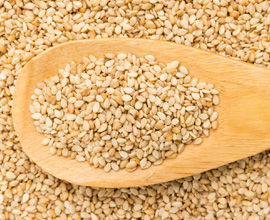Sesame (Sesamum indicum), also known as benne, is an erect annual plant in the Pedaliaceae family. The sesame plant is found in most of the tropical, subtropical, and southern temperate areas of the world. Sesame is the oldest crop known to humanity, and it is known as a survivor crop due to the conditions under which it grows.
Sesame seeds are a high-nutritional-value seed that is high in minerals. They are an excellent source of copper and a good source of calcium, iron, magnesium, manganese, and phosphorus.
Sesame is an ancient oil crop that provides seed for confectionery, edible oil, paste (Tahina), Halva, and the bakery industry. Sesame seed contains the most oil of any seed. Sesame seed oil is used as a salad oil or cooking oil, as well as in the production of soaps, pharmaceuticals, and lubricants. The press cake that remains after the oil is extracted is extremely nutritious.
Sudan produces a large percentage of the world total annual exports. Sesame is grown almost entirely under rainfed conditions in Sudan, primarily in Southern Kordofan, Kasala, the white and blue Nile states, Sennar, Gadarif, and Darfur.
Depending on the cultivar obtained, sesame seeds can vary in color. Sudan exports three different grades of sesame: white sesame commercial grade, white sesame Gadarif Grade, and red/brown (golden) sesame.
Sesame Seeds Specifications
White sesame
Oil Content Min. 48%
Admixture Max. 1%
Purity Min. 99%
Foreign matter Max. 1%
FFA Max. 2%
Other color seeds Max. 2%
Red sesame:
Oil Content Min. 52%
Admixture Max. 1%
Purity Min. 99%
Foreign matter Max. 3%
FFA Max. 3%
Other color seeds Max. 3%
Mixed Sesame seeds:
Oil Content Min. 50%
Admixture Max. 3%
Moisture Max. 6%


